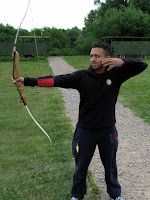10 Steps to Successful Archery Shooting
Stance
The archer stands upright in a comfortable, relaxed position with feet at right angles to the target. The feet should be about shoulder width apart. When Shooting the body position should remain as steady as possible with no shifting of weight or leaning of the body. When instructed pick up the bow and hold in the table top position.
Nocking the Arrow
Nock the arrow by placing the nock of the arrow onto the bowstring at the nocking point. Make sure that the odd coloured fletching on the arrow is facing up and the nock is pushed firmly onto the bowstring listen for the click. The arrow shaft is placed onto the arrow rest.
Which hand is which?
Drawing Hand
Index, second and third fingers are used. Curl the fingers around the bowstring so that the first joint of all three fingers sit on the bowstring. During the draw maintain an even amount of pressure on all three fingers.
Bow Hand
Hold the Bow between thumb and index finger where it makes a V. During the draw, the force should be taken on the palm and directly into the wrist. The fingers should remain relaxed.
Bow Arm & Pre Draw
Push out the bow arm towards the target so it is straight then raise the bow arm and drawing arm together, up to the position shown in the picture on the left. Keep the front shoulder in its normal low position. The shoulder must not be allowed to rotate up or back as this shortens the draw length. Keep the elbow of the drawing arm high, as this will help use the back muscles needed to draw the bow to full draw.Drawing The Bow
Draw the arm backwards in one smooth motion until the drawing hand is placed against the face, with a high elbow to make a T-shape. The position of the head and body should not move. An equal amount of push on the bow hand and pull on the drawing hand will keep the body balanced.
 Anchor
Anchor
The Anchor is where the drawing hand is positioned on the face. The thumb is tucked away in the palm of the hand with the bowstring touching the face. To ensure consistency in shooting your anchor should be the same.
Aiming
Release
 To release the arrow correctly, the fingers holding the bowstring must allow the string to slip off the fingers at the same time. This will let the bowstring pull away from the fingers with the least amount of deflection. When the release is done correctly, the hand should move backwards to rest behind the neck. Flexing the finger muscles will create a loss of power in the shot.
To release the arrow correctly, the fingers holding the bowstring must allow the string to slip off the fingers at the same time. This will let the bowstring pull away from the fingers with the least amount of deflection. When the release is done correctly, the hand should move backwards to rest behind the neck. Flexing the finger muscles will create a loss of power in the shot. Follow through

Stay in this position until the arrow hits the target.
As the arrow slides along the arrow rest any movement of the bow will affect the arrow.
Relaxing
The archer should relax after each shot to allow the muscles to recover from their effort. About 20 to 30 seconds should be enough time for the muscles to recover, ready for the next shot. If not enough time is allowed between shots, then the muscles will tire rapidly and may even become sore. Tired muscles will not be able to perform consistently.
Taster Archery sessions are available at the Leicester Outdoor Pursuits Centre.
LOPC also runs Archery Instructor courses in the East Midlands.
24th European Archery Championship which will take place 23-29 May in Nottingham, England















